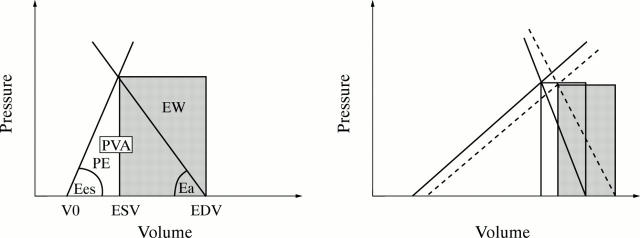Figure 2 .
(Left) Work efficiency in normal subjects. Ees represents the slope of the left ventricular end systolic pressure−volume relation, and Ea the slope of the arterial end systolic pressure−stroke volume relation. External work (EW) (area in grey), the mechanical cardiac work, represents the area bounded by the pressure−volume trajectory of one beat. Pressure−volume area (PVA) represents the area bounded by the end systolic pressure−volume relation, the end diastolic pressure−volume relation, and the systolic pressure−volume trajectory of the contraction. Potential energy (PE) is the difference between PVA and EW. EW/PVA represents the work efficiency. ESV, end systolic volume; EDV, end diastolic volume; V0 is the volume axis intercept of the end systolic pressure−volume relation. (Right) Effect of a heart rate lowering drug on work efficiency in patients with heart failure. In comparison with basal conditions (solid lines and white area), negative chronotropic effect (dashed lines and grey area) considerably reduces Ea and Ees to a lower extent, resulting in a fall in the Ea/Ees ratio, so that EW/PVA significantly increases, meaning an increase in work efficiency. (Adapted from Yamakawa H, Takeuchi M, Takaoka H, et al. Circulation 1996;94:340-5, with permission of American Heart Association.)

